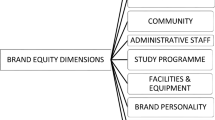Abstract
For this research we developed a series of questions for students at a small, private, not-for-profit institution in order to determine whether or not the students’ perceptions match what the institution believes itself to be as expressed in its brand promise statement. We examined whether or not the institution’s marketing and its brand help students form a perception that matches reality. Results show that incoming freshmen students, the same students at the end of the first year, and also exiting seniors perceived the institution consistently and in accordance with its brand promise. Results help to inform recruiting strategies and strategic planning.
Similar content being viewed by others
References
Abelman, R., Dalessandro, A., Janstova, P., & Snyder-Suhy, S. (2007). Institutional vision at proprietary schools: Advising for profit. NACADA Journal, 27(2), 9–27.
Anctil, E. J. (2008). Selling higher education: Marketing and advertising America’s colleges and universities. ASHE Higher Education Report, 34(2). San Francisco, CA: Jossey-Bass.
Artsci. (2008). Branding and positioning. Retrieved from www.artsci.com/consultingbrand.htm
Baldwin, A. (2005). The community college experience. Columbus, OH: Prentice Hall.
Banta, T., Lund, J., Black, K., & Oblander, F. (1995). Assessment in practice: Putting principles to work on college campuses. San Francisco, CA: Jossey-Bass.
Barley, S., & Tolbert, P. (1997). Institutionalization and structuration: Studying the links between action and institution. Organization Studies, 18(1), 93–117.
Bensimon, E. M., & Neumann, A. (1993). A different way to think about leadership teams: Teams as cultures. In E. M. Bensimon & A. Neumann (Eds.), Redesigning collegiate leadership: Teams and teamwork in higher education (pp. 15–31). Baltimore, MD: Johns Hopkins University Press.
Bryson, S. M. (2004). Strategic planning for public and nonprofit organizations: A guide to strengthening and sustaining organizational achievement. San Francisco, CA: Jossey-Bass.
Carey, K. (2010, June 6). The chimera of college brands. The Chronicle of Higher Education. Retrieved August 20, 2010, from http://chronicle.com/article/The-Chimera-of-College-Brands/65764
Davis, S., & Dunn, M. (2002). Building the brand-driven business: Operationalize your brand to drive profitable growth. San Francisco, CA: Jossey-Bass.
Denzin, N. K. (1989). The research act (3rd ed.). Englewood Cliffs, NJ: Prentice-Hall.
Detert, J. R., Schroeder, R. G., & Mauriel, J. J. (2000). A framework for linking culture and improvement initiatives in organizations. Academy of Management Review, 25(4), 850–863.
Eich, R. K. (2006). Your reputation precedes you. Trusteeship, 14(3), 13–17.
Gallant, T. B. (2007). The complexity of integrity culture change: A case study of a liberal arts college. The Review of Higher Education, 30(4), 391–411.
Helgesen, O. (2008). Marketing for higher education: A relationship marketing approach. Journal of Marketing for Higher Education, 18(1), 50–78.
HMR Publications Group (2009). 24th Annual higher education marketing yearbook. Retrieved September 10, 2010 from http://www.hmrpublicationsgroup.com/Higher_Ed_Marketing_Report/hemr_yearbooks.html
Kirp, D. L. (2003). Shakespeare, Einstein, and the bottom line: The marketing of higher education. Cambridge, MA: Harvard University Press.
Kuh, G. D., & Whitt, E. J. (1988). The invisible tapestry: Culture in American colleges and universities. ASHE-ERIC Higher Education Report No. 1. Washington, DC: Association for the Study of Higher Education.
Lincoln, Y. S., & Guba, E. G. (1985). Naturalistic inquiry. Newbury Park, CA: Sage.
Marketing Leadership Council. (2001). Measuring marketing performance: Results of council survey. Washington, DC: Marketing Leadership Council.
Marom, D. (2003). Before the gates of school: An experiment in developing educational vision from practice. In S. Fox, I. Scheffler, & D. Marom (Eds.), Vision of Jewish education (pp. 296–298). Cambridge, MA: Cambridge University Press.
Mason, J. (1996). Qualitative researching. Beverly Hills, CA: Sage.
Merriam, S. B. (1998). Qualitative research and case study applications in education: Revised and expanded from case study research in education (2nd ed.). San Francisco, CA: Jossey-Bass.
National Center for Higher Education Management Systems. (2010). Progress and completion: Retention rates - first-time college freshmen returning their second year. Retrieved September 10, 2010. From http://www.higheredinfo.org/dbrowser/index.php?level=&mode=definitions&state=0&submeasure=224
Oklahoma City University. (2003). Senior survey. Oklahoma City, OK: Oklahoma City University.
Oklahoma City University. (2007). Institutional culture survey. Oklahoma City, OK: Oklahoma City University.
Oklahoma City University. (2009). Retention to graduation – 1995 to 2008. Oklahoma City, OK: Oklahoma City University.
Saldaña, J. (2009). The coding manual for qualitative researchers. Thousand Oaks, CA: Sage.
Schein, E. H. (1992). Organizational culture and leadership (2nd ed.). San Francisco, CA: Jossey-Bass.
Sevier, R. A. (2007). Delivering on your brand experience. University Business, 11(12), 34–36.
Smirich, L. (1983). Studying organizations as cultures. In G. Morgan (Ed.), Beyond method: Strategies for social research (pp. 160–172). Beverly Hills, CA: Sage.
Tinto, V. (2006). Research and practice of student retention: What next? Journal of College Student Retention, 8(1), 1–19.
University Business. (2008). 50 best branding ideas. University Business, 12(12), 45–50.
Waeraas, A., & Solbakk, M. N. (2009). Defining the essence of a university: Lessons from higher education branding. Higher Education: The International Journal of Higher Education and Educational Planning, 57(4), 449–462.
Wheatley, C. (2002). Delivering the brand experience: Keeping the promise. In D. J. Burnett & D. G. Oblinger (Eds.), Innovation in student services: Planning models blending high touch/high tech (pp. 15–22). Ann Arbor, MI: Society for College and University Planning.
Wilson, R. (2006). The dynamic of organization culture and academic planning. Society for College and University Planning, 34(3), 5–17.
Acknowledgements
The authors would like to thank the editor; reviewers; the attendees of the American Association of Behavioral and Social Sciences; and the attendees of the International Conference on Knowledge, Culture, and Change in Organizations who provided helpful comments on this research. Also, we thank Dr. Joseph L. Rodgers for editing and providing critical comments.
Author information
Authors and Affiliations
Corresponding author
Rights and permissions
About this article
Cite this article
Rodgers, J.L., Jackson, M.W. Are We Who We Think We Are: Evaluating Brand Promise at a Liberal-Arts Institution. Innov High Educ 37, 153–166 (2012). https://doi.org/10.1007/s10755-011-9187-7
Published:
Issue Date:
DOI: https://doi.org/10.1007/s10755-011-9187-7




